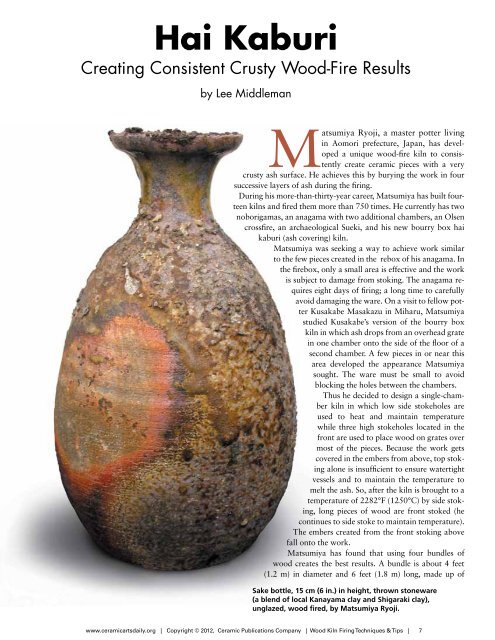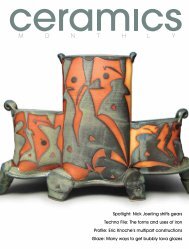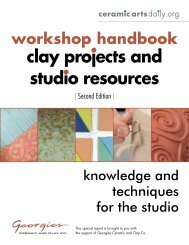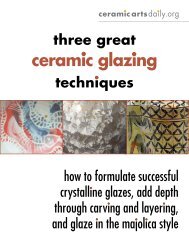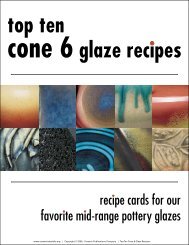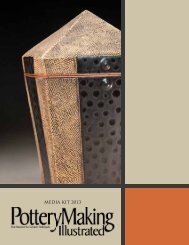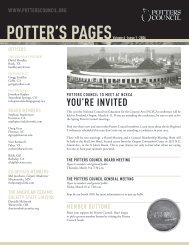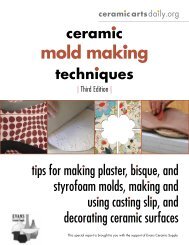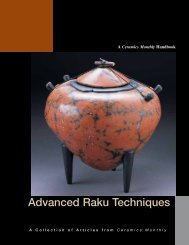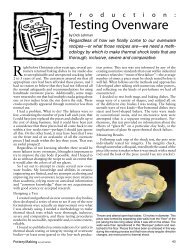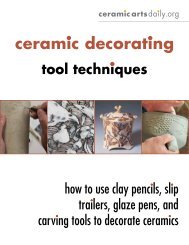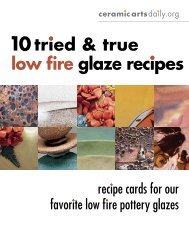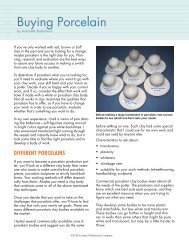wood kiln firing techniques & tips techniques & tips - Ceramic Arts ...
wood kiln firing techniques & tips techniques & tips - Ceramic Arts ...
wood kiln firing techniques & tips techniques & tips - Ceramic Arts ...
Create successful ePaper yourself
Turn your PDF publications into a flip-book with our unique Google optimized e-Paper software.
Hai Kaburi<br />
Creating Consistent Crusty Wood-Fire Results<br />
by Lee Middleman<br />
Matsumiya Ryoji, a master potter living<br />
in Aomori prefecture, Japan, has developed<br />
a unique <strong>wood</strong>-fire <strong>kiln</strong> to consistently<br />
create ceramic pieces with a very<br />
crusty ash surface. He achieves this by burying the work in four<br />
successive layers of ash during the <strong>firing</strong>.<br />
During his more-than-thirty-year career, Matsumiya has built fourteen<br />
<strong>kiln</strong>s and fired them more than 750 times. He currently has two<br />
noborigamas, an anagama with two additional chambers, an Olsen<br />
crossfire, an archaeological Sueki, and his new bourry box hai<br />
kaburi (ash covering) <strong>kiln</strong>.<br />
Matsumiya was seeking a way to achieve work similar<br />
to the few pieces created in the rebox of his anagama. In<br />
the firebox, only a small area is effective and the work<br />
is subject to damage from stoking. The anagama requires<br />
eight days of <strong>firing</strong>; a long time to carefully<br />
avoid damaging the ware. On a visit to fellow potter<br />
Kusakabe Masakazu in Miharu, Matsumiya<br />
studied Kusakabe’s version of the bourry box<br />
<strong>kiln</strong> in which ash drops from an overhead grate<br />
in one chamber onto the side of the floor of a<br />
second chamber. A few pieces in or near this<br />
area developed the appearance Matsumiya<br />
sought. The ware must be small to avoid<br />
blocking the holes between the chambers.<br />
Thus he decided to design a single-chamber<br />
<strong>kiln</strong> in which low side stokeholes are<br />
used to heat and maintain temperature<br />
while three high stokeholes located in the<br />
front are used to place <strong>wood</strong> on grates over<br />
most of the pieces. Because the work gets<br />
covered in the embers from above, top stoking<br />
alone is insufficient to ensure watertight<br />
vessels and to maintain the temperature to<br />
melt the ash. So, after the <strong>kiln</strong> is brought to a<br />
temperature of 2282°F (1250°C) by side stoking,<br />
long pieces of <strong>wood</strong> are front stoked (he<br />
continues to side stoke to maintain temperature).<br />
The embers created from the front stoking above<br />
fall onto the work.<br />
Matsumiya has found that using four bundles of<br />
<strong>wood</strong> creates the best results. A bundle is about 4 feet<br />
(1.2 m) in diameter and 6 feet (1.8 m) long, made up of<br />
Sake bottle, 15 cm (6 in.) in height, thrown stoneware<br />
(a blend of local Kanayama clay and Shigaraki clay),<br />
unglazed, <strong>wood</strong> fired, by Matsumiya Ryoji.<br />
www.ceramicartsdaily.org<br />
www.ceramicartsdaily.org<br />
| Copyright<br />
| Copyright<br />
© 2011,<br />
©<br />
<strong>Ceramic</strong><br />
2012, <strong>Ceramic</strong><br />
Publications<br />
Publications<br />
Company<br />
Company<br />
| Wood<br />
|<br />
Firing<br />
Wood<br />
Techniques<br />
Kiln Firing<br />
&<br />
Techniques<br />
Tips | Second<br />
& Tips<br />
Edition<br />
| 7<br />
| 7


